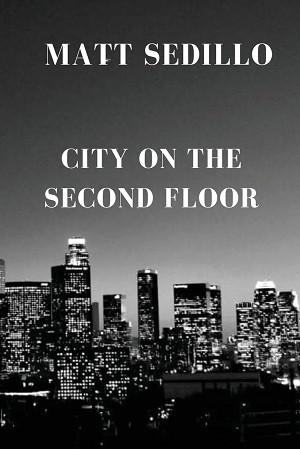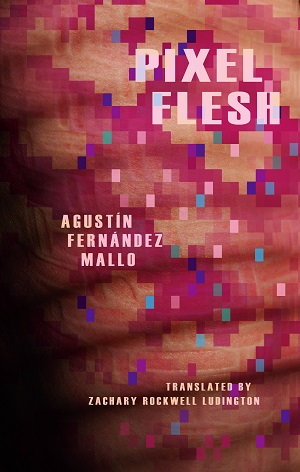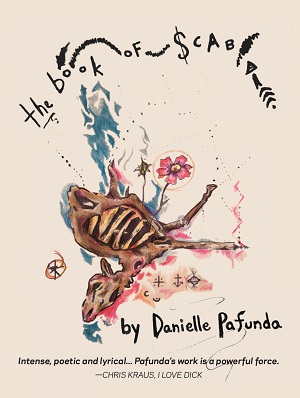
Poetry by Matt Sedillo
Review by Frank Mundo
I was watching Disney’s “Encanto” with the kids when the mail arrived with Matt Sedillo’s new book of poetry, “City on the Second Floor” from FlowerSong Press, and I thought, how perfect is that? Here’s Matt Sedillo, extremely popular Chicano political poet, essayist, activist (the hardest working poet I know) – and yet somehow he’s become like the Bruno of certain parts of the Los Angeles poetry scene. His poetry superpower is so electric and engaging that most are absolutely dazzled and inspired by his voice, while the rest are left frightened (even triggered) and dismissive of his ostensibly dark and angry premonitions. Plus, he’s a troll, they say. He’s a communist with Das Kapital C. He’s (God forbid) a renegade. Self-taught? He didn’t even go to college.
Maybe that’s why, despite all he’s done for the poetry community in Los Angeles for a dozen years or so, we haven’t seen even a mention of Sedillo (or his three books) in the LA Times since he won the L.A. Grand Slam championship in 2011. Perhaps that’s why, no matter how hard he works and finds success, he’s never been the poet in conversation at Rattle. And, maybe it’s why, like his second book, “Mowing Leaves of Grass,” his newest book will likely never be reviewed or discussed by the Los Angeles Review of Books.
Maybe it’s just me, but, in certain parts of Los Angeles, it seems we don’t talk about Matt Sedillo – at least, not nearly as much as we should. And I just don’t understand why. Many compare him to Amiri Baraka, Jose Montoya, and so many other fiery or political poets. To me, his work is a cross between Allen Ginsberg and Wanda Coleman. So why isn’t everyone in LA talking about his new book, “City on the Second Floor,” which is flying off the shelves, by the way.
One criticism you’ll hear way too often is that Sedillo’s poetry is too angry. This is a lazy and shallow reading (or listening) of his work. Yes, there is anger in his poetry, and a lot of it, but it’s almost always tempered with humor, which can never be done effectively without empathy and compassion. Sedillo’s speaker addresses this idea in “Post,” the very first poem of the 32 poems and one play collected in “City on the Second Floor.” And I can almost guarantee that Sedillo or his publisher placed this piece first in the collection intentionally. There’s no way this was a coincidence.
“Post” begins looking back (even reminiscing, you might say) to a time of the service economy (when what? America was great?) – “…just like yesterday/ Municipalities raised cities/ Built nuclear families/ Associations of sturdy pockets/ A two-car garage, chicken in every pot.” What follows is their broken promise of tomorrow, “…which doesn’t show up all at once,” the speaker tells us, “But when it does…” it’s with liquidated pensions and automated factories – and the resulting gig economy left in a shambles to a generation who “…cannot afford to live in…” the very cities where they must hustle only to get part-time, freelance, contract, and “adjunct” employment. “Promise me the world, then show me the door,” Sedillo’s speaker concludes. “I was not/ Born/ Angry/ I was abandoned.”
Yet, even with that last line, as justifiable as the “anger” might be for this speaker (and Sedillo’s generation), I think a lot of critics who only want to see anger will miss the fabulous punchline at the end of the poem – “Tell me the one/ Where I killed the economy.”
I love this line, not only because it’s hilarious, but because it’s so accurate. Often accused of being whiners and lazy, Millennials are also blamed somehow for ruining the very broken economy they inherited. But I would argue that there’s nothing overly angry in this line. This is not an “OK, Boomer” sarcastic snowflake moment. This is more of a mic-drop moment – a humorous wink and a nod to the “us” in the us-versus-them structure that makes up so much of Sedillo’s poetry.
Even the title “Post” is a funny play on words of old versus new. Is this the postindustrial standard? Is this a letter? A social media post? Is this a signpost? Or is it a warning, like so many other poems in the collection about how consumerism, credit, and debt will ruin us all? Maybe it’s all these things and a hint of what to expect in the following pages of an angry and funny and compassionate collection.
Sedillo reworks this poem later in the book (sort of in reverse) in a poem called, “Hammurabi,” which is laugh-out-loud funny. This one ends with a deadly serious punchline, “Since they from on high/ Convinced us down below/ That we/ Ever/ Needed/ Their/ Code/ Of law/ To tell us/ We were free.” What’s funny is that the lies about the future in this remix of “Post” come from the TV characters we so loved and trusted: Lucy Ricardo, Mr. Belvedere, Homer Simpson, Peter Griffin, and especially Al Bundy (all comedies, mind you) who convinced us that we “…could raise a family/ In a two story/ On the single income/ Of a shoe salesman.” LOL.
I wanted to make sure that I wasn’t the only one who believed Matt Sedillo’s poetry is as funny as it is angry. Maybe I just have a dark sense of humor. So, I called up Mike “the Poet” Sonksen, a poet, scholar, journalist, critic, mentor, and author with an encyclopedic knowledge of the history of poetry in Los Angeles. I respect Mike’s opinion so much because he focuses on poetry of merit, not simply the styles and genres he prefers. If anyone anywhere in LA is writing or “spitting” quality verse, he knows about it, writes about it, talks about – because he’s all about it and has been for 25 years.
“Matt Sedillo is relentless,” Mike told me. “He’s a student of history and skilled at spinning his astute understanding into engaging poetry,” and I couldn’t agree more. He also said, “Sedillo can also be quite funny, satirizing the powers that be with poetic one-liners. His social commentary balances truth and wit to produce a poetic velocity faster than Starsky & Hutch.”
Another poem I loved from the book, “Pope of Broadway,” literally starts as a classic joke: “An Arab, an Italian, a Jew, a Puerto Rican, an Inuit, an American Indian, a Mongolian/ And a Mexican/ Walk into a bar…” and “Anthony Quinn orders a drink.” This is a wonderful and complex poem about the “ethnically ambiguous” actors (the “every” Brown-man) in Hollywood, from Quinn (who was the best) to today’s other “two first-name” actors who continue this unusual tradition today, including Cliff Curtis and Oscar Isaac.
I like this poem also because I spoke about this concept (and the larger and darker meaning behind it) with Matt Sedillo a couple years ago, before he had written the piece. And reading the final product in his new book was a real treat for me.
That day, I also asked Matt what his goal was when writing a poem. “First,” he said, “it’s to satisfy the demands of structure.” Matt often uses a three-act structure that he has developed and refined over the years and made his own. It’s one of the major topics he discusses and often teaches as a highly in-demand speaker/performer at the top colleges and universities in America and at several other major venues in Canada, England, and Cuba. “Second,” Matt continued, “no matter what the theme is, I want to write poems (not every time, but I try) that are calls to action.” It’s not surprising to me that his answer is all about craft. Matt sees craft everywhere. He studies it and looks for patterns and anomalies in everything. He’ll read texts or study videos of fiery speakers, like Hugo Chavez and Michael Parenti, and spend hours breaking down their prose, examining what they say and how they say it. He’ll study the timing of stand-up comics, books, films, commercials, anything that tells stories in an engaging way that gets people to act.
In “Mowing Leaves of Grass,” Sedillo’s first book with FlowerSong Press from 2019, his craft, especially his three-act structure is in full effect. It’s the work that put him on the map as a unique and powerful voice in Los Angeles and beyond. The poems in his latest book, “City on the Second Floor,” however, offer a glimpse, I believe, of where his poetry is headed: even more powerful, political, angry, funny, timely, smart, carefully crafted, and compassionate calls to action.
I also asked Matt Sedillo who influences him and his writing, and I was a little surprised by his answer. An avid student of history, Matt listed artists who are still alive and very active in the community. He said Luis J. Rodriguez, the 2014 Los Angeles Poet Laureate. He also mentioned other poets whose work inspired him: spoken word artist David A. Romero, author of “My Name is Romero,” and Viva Padilla, Publisher/ Editor-in-Chief of Dryland, a literary journal.
Finally, I wanted to know about Matt Sedillo’s publisher, so I contacted Edward Vidaurre, Publisher/Editor-in-Chief of FlowerSong Press, and I asked him straight out why he chose to publish such an outspoken and, perhaps, controversial poet as Matt Sedillo. Without hesitation, Vidaurre answered, “Because, like me, he is fearless about his work. He’s a necessary voice in a world where being an activist is sometimes looked on as trouble.” Finally, he added – and it all made perfect sense to me – “I wanted his collection to make noise and open eyes.”
I suppose the gatekeepers and kingmakers of the Los Angeles literary scene will do what they want to do – and they still might not talk about Matt Sedillo after my little plea here. But, with Sedillo’s incredible work ethic, his determination and dedication to craft, and his fearless and supportive publisher’s commitment to sharing “necessary” voices and books, I know we will definitely be hearing much more “noise” from him.
City on the Second Floor is available now from FlowerSong Press.
Frank Mundo is a poet from Los Angeles. His latest chapbooks are Touched by an Anglo (Kattywompus Press) and Eleven Sundry Flowers (Antrim House).







 Inquisition, by Kazim Ali
Inquisition, by Kazim Ali Othered, by Randi Romo
Othered, by Randi Romo Orange Lady, by Erika Ayón
Orange Lady, by Erika Ayón